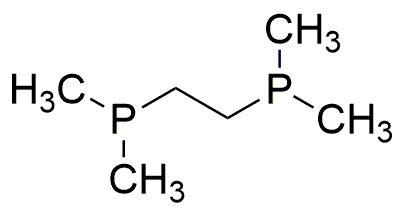1,2-Bis(dimethylphosphino)ethane is widely utilized in research focused on:
- Catalysis: This compound serves as a ligand in various catalytic processes, enhancing the efficiency of reactions in organic synthesis and industrial applications.
- Coordination Chemistry: It is valuable in the formation of metal complexes, which are crucial for developing new materials and catalysts in the chemical industry.
- Pharmaceutical Development: The compound plays a role in drug design, particularly in creating phosphine-based compounds that can improve the efficacy of pharmaceutical agents.
- Environmental Chemistry: It is used in studies aimed at developing methods for pollutant removal, contributing to cleaner technologies and sustainable practices.
- Research in Organometallic Chemistry: This chemical is essential for exploring new organometallic compounds, which can lead to innovations in various fields, including electronics and materials science.
General Information
Properties
Safety and Regulations
Applications
1,2-Bis(dimethylphosphino)ethane is widely utilized in research focused on:
- Catalysis: This compound serves as a ligand in various catalytic processes, enhancing the efficiency of reactions in organic synthesis and industrial applications.
- Coordination Chemistry: It is valuable in the formation of metal complexes, which are crucial for developing new materials and catalysts in the chemical industry.
- Pharmaceutical Development: The compound plays a role in drug design, particularly in creating phosphine-based compounds that can improve the efficacy of pharmaceutical agents.
- Environmental Chemistry: It is used in studies aimed at developing methods for pollutant removal, contributing to cleaner technologies and sustainable practices.
- Research in Organometallic Chemistry: This chemical is essential for exploring new organometallic compounds, which can lead to innovations in various fields, including electronics and materials science.
Documents
Safety Data Sheets (SDS)
The SDS provides comprehensive safety information on handling, storage, and disposal of the product.
Product Specification (PS)
The PS provides a comprehensive breakdown of the product’s properties, including chemical composition, physical state, purity, and storage requirements. It also details acceptable quality ranges and the product's intended applications.
Certificates of Analysis (COA)
Search for Certificates of Analysis (COA) by entering the products Lot Number. Lot and Batch Numbers can be found on a product’s label following the words ‘Lot’ or ‘Batch’.
Numéro de catalogue
Numéro de lot/série
Certificates Of Origin (COO)
This COO confirms the country where the product was manufactured, and also details the materials and components used in it and whether it is derived from natural, synthetic, or other specific sources. This certificate may be required for customs, trade, and regulatory compliance.
Numéro de catalogue
Numéro de lot/série
Safety Data Sheets (SDS)
The SDS provides comprehensive safety information on handling, storage, and disposal of the product.
DownloadProduct Specification (PS)
The PS provides a comprehensive breakdown of the product’s properties, including chemical composition, physical state, purity, and storage requirements. It also details acceptable quality ranges and the product's intended applications.
DownloadCertificates of Analysis (COA)
Search for Certificates of Analysis (COA) by entering the products Lot Number. Lot and Batch Numbers can be found on a product’s label following the words ‘Lot’ or ‘Batch’.
Numéro de catalogue
Numéro de lot/série
Certificates Of Origin (COO)
This COO confirms the country where the product was manufactured, and also details the materials and components used in it and whether it is derived from natural, synthetic, or other specific sources. This certificate may be required for customs, trade, and regulatory compliance.


